Welcome to the world of Bushidan Judo, a martial art that embodies discipline, skill, and a deep sense of tradition. In this article, we will explore the essence of Bushidan Judo, its history, principles, and how it can be practiced to attain mastery in this ancient art.
The origins of bushidan judo
Bushidan Judo, often referred to simply as Bushidan, traces its roots back to Japan, where it was developed as a martial art and combat sport in the late 19th century. The word „Bushidan” can be translated as „the way of the warrior’s discipline,” and it encapsulates the core philosophy of this martial art.
Founded by Jigoro Kano in 1882, Judo evolved from traditional Japanese jiu-jitsu techniques. Kano aimed to create a more practical and efficient martial art that could be practiced safely as a sport. He succeeded in his mission, and Judo quickly gained popularity both in Japan and around the world.
The principles of bushidan judo
At the heart of Bushidan Judo are several fundamental principles that guide practitioners on their journey to mastery. These principles are:
- Ju-no-ri – The principle of flexibility and adaptability. In Judo, one learns to yield to an opponent’s force and use it to their advantage.
- Jita-kyoei – The principle of mutual benefit and welfare. Judo emphasizes the development of both physical and mental strength for the betterment of society.
- Seiryoku-zenyo – The principle of maximum efficiency with minimum effort. Practitioners of Judo strive to use their energy and techniques effectively to achieve their goals.
The path to mastery in bushidan judo
Becoming a true master in Bushidan Judo requires dedication, perseverance, and a deep understanding of its principles. Here are the key steps on the path to mastery:
1. Basic Techniques
Beginners start by learning the foundational techniques of Judo, including throws, pins, joint locks, and strangles. These form the basis for more advanced moves and strategies.
2. Randori
Randori is a practice in which a Judoka faces multiple opponents. It helps develop quick thinking, adaptability, and the ability to apply techniques in real-time situations.
3. Kata
Kata are prearranged forms that simulate combat scenarios. They help refine techniques, posture, and precision. Mastering kata is a significant step toward proficiency in Bushidan Judo.
4. Shiai
Competing in Judo tournaments, or shiai, allows practitioners to test their skills against others. It fosters a competitive spirit and helps refine one’s techniques under pressure.
5. Teaching and Sharing Knowledge
To truly reach the highest levels of mastery, a Judoka often becomes an instructor, passing down their knowledge to the next generation. Teaching is not only a way to give back but also a path to further personal growth.
Faqs
Q1: Is Bushidan Judo suitable for all ages?
A1: Yes, Judo is a martial art that can be practiced by people of all ages, from children to seniors. It offers a range of benefits, including physical fitness and self-defense skills.
Q2: Can I practice Bushidan Judo alone?
A2: While Judo is primarily a partner-based martial art, there are solo drills and exercises that can help improve your skills, balance, and flexibility.
Q3: How long does it take to reach black belt level in Judo?
A3: The time it takes to achieve a black belt in Judo varies from person to person. On average, it may take several years of consistent training and dedication.
In conclusion, Bushidan Judo is not just a martial art; it’s a way of life that promotes physical and mental growth, mutual respect, and the pursuit of excellence. Whether you are a beginner taking your first steps on the mat or a seasoned practitioner striving for mastery, the path of Bushidan Judo offers a lifelong journey of self-discovery and personal development.
Zobacz także:





